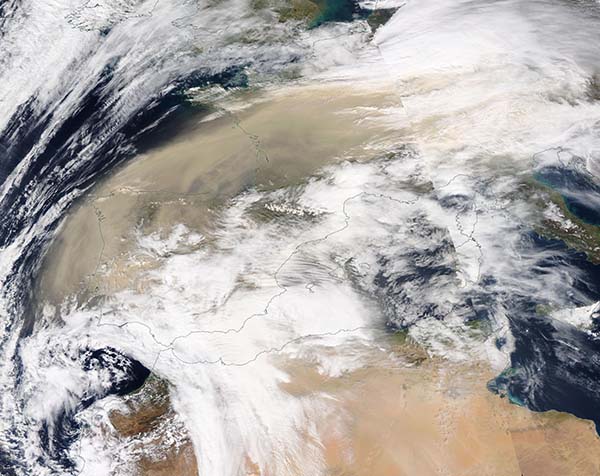Images
March 17, 2022 - Dust over Europe
Tweet
On March 15, 2022, the Moderate Resolution Imaging Spectroradiometer (MODIS) on board NASA’s Aqua satellite acquired a true-color image of a blanket of dust so thick that it obscured most of Spain, Portugal, and France from view. That morning, a massive plume of Saharan dust was blown out of North Africa and across the Mediterranean into Western Europe. The dust turned skies orange, blanketed cities, impaired air quality, and stained ski slopes.
The plume was driven by an atmospheric river arising from Storm Celia, which brought strong winds, rain, and snow to the Canary Islands. Atmospheric rivers, normally associated with extreme moisture, can also carry dust. A study published in March 2022 in the journal ‘Atmospheric Research’ identified for the first time the occurrence of dust-laden atmospheric rivers flowing towards Europe via a new pathway: originating in the eastern Atlantic Ocean and flowing across the Sahara Desert. While not extremely common, when such atmospheric rivers pass over northwestern Africa, they often lead to extreme dust events over Europe.
Over the past four decades, 78 percent of atmospheric rivers over northwestern Africa have led to extreme dust events over Europe, according to research by Guan and colleagues. Such “aerosol atmospheric rivers”—a term recently introduced in a NASA-led study that refers to narrow, elongated regions of extreme aerosol mass transport—can play an important role in climate and air quality around the world.
Each year, more than 100 million tons of dust blow out of North Africa, lofted from the Sahara Desert by strong seasonal winds. At least a few times a year, strong and persistent winds from the south drive Saharan dust north toward Europe. At other times, they may cross the Atlantic Ocean to reach South or North America.
The dust plays a major role in Earth’s climate and biological systems, absorbing and reflecting solar energy and fertilizing ocean ecosystems with iron and other minerals that plants and phytoplankton need to grow. But such massive dust events can decrease the amount of sunlight reaching the surface through reflection and absorption, affect cloud formation, degrade air quality, and have negative health effects.
Image Facts
Satellite:
Aqua
Date Acquired: 3/15/2022
Resolutions:
1km (1.1 MB), 500m (4.3 MB),
Bands Used: 1,4,3
Image Credit:
MODIS Land Rapid Response Team, NASA GSFC
Tweet
On March 15, 2022, the Moderate Resolution Imaging Spectroradiometer (MODIS) on board NASA’s Aqua satellite acquired a true-color image of a blanket of dust so thick that it obscured most of Spain, Portugal, and France from view. That morning, a massive plume of Saharan dust was blown out of North Africa and across the Mediterranean into Western Europe. The dust turned skies orange, blanketed cities, impaired air quality, and stained ski slopes.
The plume was driven by an atmospheric river arising from Storm Celia, which brought strong winds, rain, and snow to the Canary Islands. Atmospheric rivers, normally associated with extreme moisture, can also carry dust. A study published in March 2022 in the journal ‘Atmospheric Research’ identified for the first time the occurrence of dust-laden atmospheric rivers flowing towards Europe via a new pathway: originating in the eastern Atlantic Ocean and flowing across the Sahara Desert. While not extremely common, when such atmospheric rivers pass over northwestern Africa, they often lead to extreme dust events over Europe.
Over the past four decades, 78 percent of atmospheric rivers over northwestern Africa have led to extreme dust events over Europe, according to research by Guan and colleagues. Such “aerosol atmospheric rivers”—a term recently introduced in a NASA-led study that refers to narrow, elongated regions of extreme aerosol mass transport—can play an important role in climate and air quality around the world.
Each year, more than 100 million tons of dust blow out of North Africa, lofted from the Sahara Desert by strong seasonal winds. At least a few times a year, strong and persistent winds from the south drive Saharan dust north toward Europe. At other times, they may cross the Atlantic Ocean to reach South or North America. The dust plays a major role in Earth’s climate and biological systems, absorbing and reflecting solar energy and fertilizing ocean ecosystems with iron and other minerals that plants and phytoplankton need to grow. But such massive dust events can decrease the amount of sunlight reaching the surface through reflection and absorption, affect cloud formation, degrade air quality, and have negative health effects.
Image Facts
Satellite:
Aqua
Date Acquired: 3/15/2022
Resolutions:
1km (1.1 MB), 500m (4.3 MB),
Bands Used: 1,4,3
Image Credit:
MODIS Land Rapid Response Team, NASA GSFC




